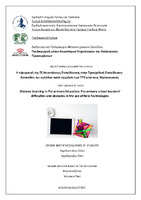"Η εφαρμογή της Εξ Αποστάσεως Εκπαίδευσης στην Προσχολική Εκπαίδευση: Δυσκολίες και εμπόδια κατά τη χρήση των ΤΠΕ από τους Νηπιαγωγούς"
“Distance Learning in Pre-primary Education: Pre-primary school teachers’ difficulties and obstacles in the use of New Technologies”

Μεταπτυχιακή διπλωματική εργασία
Συγγραφέας
Αγγελοπούλου, Ελένη
Ημερομηνία
2021-10-08Επιβλέπων
MOUSENA, ELENIΛέξεις-κλειδιά
Νηπιαγωγοί ; Δυσκολίες και εμπόδια ; Διαχείριση προβλημάτων ; Εξ αποστάσεως εκπαίδευση ; Νέες τεχνολογίεςΠερίληψη
Εισαγωγή: Η εισαγωγή των Τεχνολογιών Πληροφορικής και Επικοινωνίας (ΤΠΕ) στην
Εκπαίδευση διαμόρφωσε νέες προοπτικές στη μαθησιακή διαδικασία. Ωστόσο, η ένταξη
των ΤΠΕ στην Προσχολική Εκπαίδευση δεν ακολούθησε τους ίδιους ρυθμούς, με τις
υπόλοιπες εκπαιδευτικές βαθμίδες. Την κατάσταση αυτή ήρθε να ανατρέψει η
επιτακτική εφαρμογή της Εξ Αποστάσεως Εκπαίδευσης, λόγω των υγειονομικών
συνθηκών της πανδημίας Covid-19, και στην Προσχολική Εκπαίδευση.
Σκοπός της παρούσας εργασίας ήταν η διερεύνηση του τρόπου αξιοποίησης των ΤΠΕ
κατά την Εξ Αποστάσεως Προσχολική Εκπαίδευση, στον καιρό της πανδημίας Covid-19,
και η αποτύπωση των δυσκολιών και των εμποδίων κατά τη χρήση αυτών, από τους
Νηπιαγωγούς.
Μέθοδος: Χρησιμοποιήθηκε η βιβλιογραφική ανασκόπηση και η ποσοτική έρευνα με τη
χρήση ερωτηματολογίου. Η έρευνα διεξήχθη το διάστημα 10-30 Ιουνίου του 2021, σε
ένα δείγμα αποτελούμενο από εκατόν είκοσι έναν (121) Νηπιαγωγούς, των Δημόσιων
Νηπιαγωγείων της Πρωτοβάθμιας Διεύθυνσης της Β΄ Αθήνας. Η στατιστική ανάλυση
πραγματοποιήθηκε μέσω του στατιστικού προγράμματος SPSS.
Αποτελέσματα: Από την έρευνα προέκυψε πως το 72,7% των Νηπιαγωγών κατέχει
πιστοποιημένη γνώση στις ΤΠΕ και ότι το 95,9% χρησιμοποιεί τις ΝΤ στην εκπαιδευτική
διαδικασία. Κατά την εξΑΕ, το 75,2% των Νηπιαγωγών δήλωσε πως εφάρμοσε και τις
δύο μορφές της (Ασύγχρονη και Σύγχρονη). Μάλιστα στην Ασύγχρονη Εκπαίδευση,
χρησιμοποιήθηκαν περισσότερο η ψηφιακή τάξη (e-class) και το ηλεκτρονικό
ταχυδρομείο (e-mail), και στη Σύγχρονη Εκπαίδευση, επιλέχτηκε κυρίως η ψηφιακή
πλατφόρμα της Cisco Webex. Ως βασικότεροι παράγοντες δυσκολίας στην εξΑΕ
θεωρήθηκαν η ξαφνική εφαρμογή της (57%), το ελλιπές πλαίσιο υποστήριξης της
(44,6%), και η έλλειψη τεχνολογικών μέσων και πόρων (44,6%). Οι κυριότερες δυσκολίες
των Νηπιαγωγών, κατά την υλοποίηση των εξ αποστάσεως προγραμμάτων, ήταν ο
σχεδιασμός και η διαμόρφωση των διδακτικών δραστηριοτήτων (60,3%), η διεξαγωγή
των ίδιων των διδακτικών δραστηριοτήτων (54,5%), και η ανατροφοδότηση των
μαθητών (53,7%). Τέλος, το 59,5% των ερωτώμενων Νηπιαγωγών, πρότειναν για την
υπέρβαση των παραπάνω δυσκολιών, την Ουσιαστική Επιμόρφωσή τους (49,6%), και την
Παροχή Τεχνολογικού Εξοπλισμού στα Σχολεία (9,9%).
Συμπεράσματα: Κατά την εξΑΕ, οι Νηπιαγωγοί κατόρθωσαν, παρ’ όλες τις δυσκολίες και
τα εμπόδια, να ανταποκριθούν και να επιτελέσουν το διδακτικό τους έργο, κρατώντας
παράλληλα ενεργό το ενδιαφέρον των μαθητών τους.
Περίληψη
Introduction: The introduction of Information and Communication Technologies (ICT) in
Education has offered new perspectives to the learning process. However, the
introduction of ICT in Pre-Primary Education has not followed the same pace as in the
other educational bands. This situation came to be reversed, after the influx of the
pandemic, which made Distance Learning imperative due to the sanitary conditions.
Purpose: The purpose of this thesis was to research the way ICT have been implemented
in Distance Learning, during the pandemic period, and to pinpoint the difficulties and
obstacles the Pre-primary school teachers had to overcome in using ICT.
Method: Bibliographic review and in-the-field research using questionnaires was used.
The research was conducted among a sample of one hundred and twenty one (121) PrePrimary school teachers of B΄ Athens Primary Education Directorate, in the period
between 10 and 30 June 2021. The statistical analysis was based on the SPSS statistical
program.
Results: The research showed that 72.7% of the Pre-primary school teachers are certified
users of the Information and Communication Technologies and that 95.9% of them
comprise the New Technologies in the teaching process.
Regarding distance learning, 75.2% of the Pre-primary school teachers stated that they
had applied both the asynchronous as well as the synchronous one. The e-tool they had
used the most for the asynchronous distance learning, was the e-class and the e-mail,
while for the synchronous one, the e-platform of Cisco Webex was the one most
frequently chosen.
The main difficulties which arose from using distance learning, were due to its sudden
implementation (57%) and its inefficient support mechanism (44.6%), as well as the lack
of technical means and resources (44.6%). In the carrying out of the distance learning
curriculum, what proved to be most perplexing to the Pre-primary school teachers was
the planning and the putting-together of the educational activities (60.3%), the
implementation of the educational activities themselves (54.5% ), and the flow of
students' feedback (53.7%).
Finally, 59.5% of the surveyed Pre-primary school teachers in order to overcome the
above difficulties, suggested the in-depth training of the educators (49.6%), and the
provision of computing tools to the schools (9.9%).
Discussion: During the distance education, the Pre-primary school teachers managed,
despite the difficulties and the obstacles, to respond and to perform their educational
work, while capturing their students' interest.

